An insanely simple Christmas dinner for four people under £50
A thrifty Christmas dinner can still be festive with this budget-friendly menu from Katie Workman
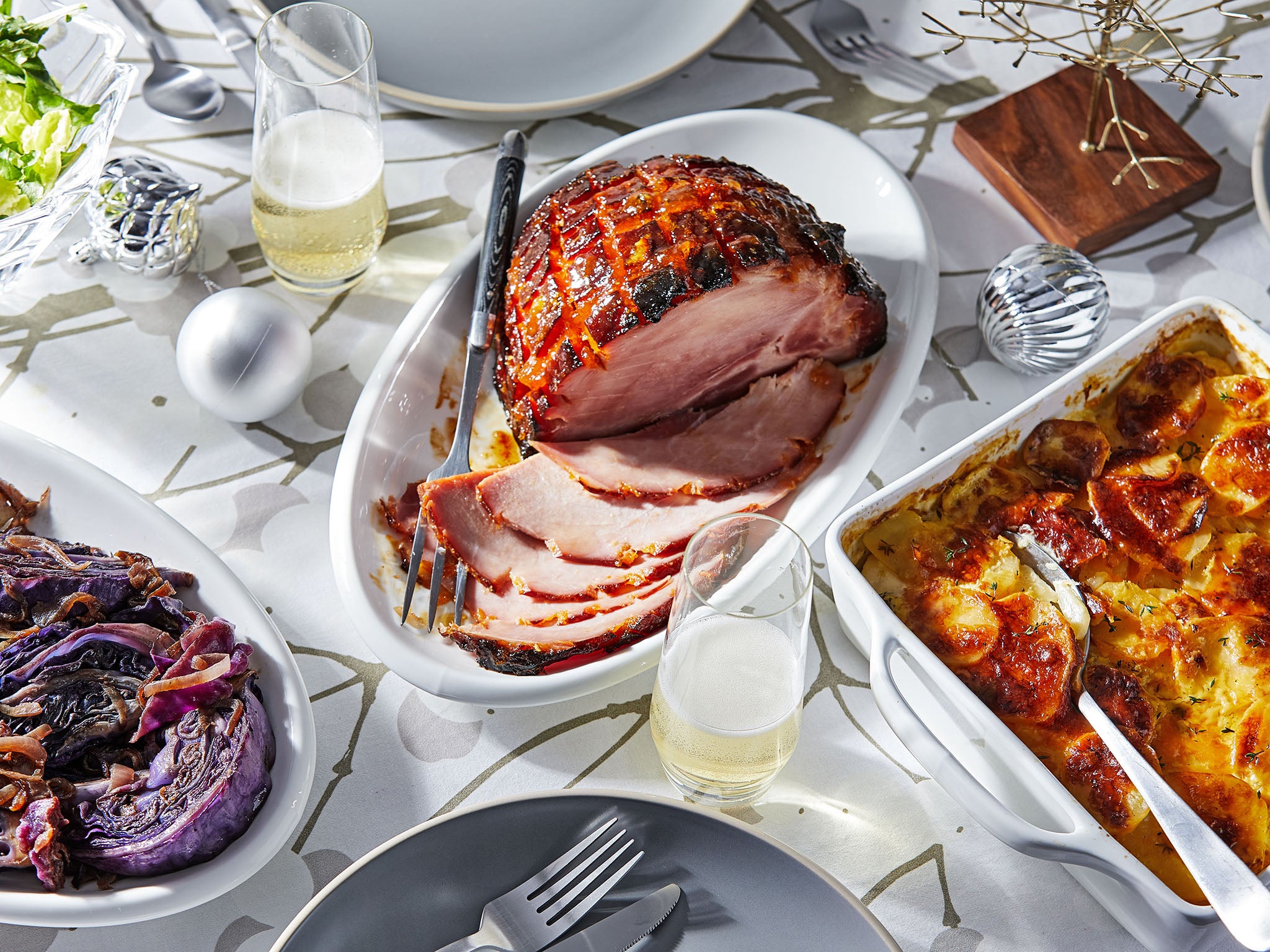
One of the realities of Christmas this year is that many people are on tighter budgets than usual. That doesn’t have to be an impediment to a sumptuous, festive roast dinner – instead, let it be like a puzzle to solve.
I set myself the goal of figuring out a dinner for four that felt 100 per cent Christmas-worthy, but cost just £50. I hope you’ll agree there is nothing about this menu that feels downscale.
The centrepiece is a glazed ham, and the good news is that hams are available in many sizes. A boneless ham portion of about 1.4kg is ample for four people, with leftovers so you can think about ham sandwiches, bean soups studded with chopped ham, ham and cheese toasties, maybe a quiche Lorraine later in the week.
If this all sounds really good, you might go for a 1.8kg ham.
I cannot tell you how much my family likes my cheddar potato gratin. There is nothing frugal about this lush dish. If you have a few more dollars to throw into the pot, treat yourself to some top-of-the-line cheddar. Leftovers will be fought over (and in my house, I will win, because I will know where they are hidden in the fridge).
And then the humble cabbage is transformed into a silky, jewel-toned side dish. This whole side is the sum total of about £3 worth of ingredients (a fact you can keep to yourself). When cabbage is first seared and then braised, it becomes meltingly tender, with a sweetness complemented by a level of flavour you can only get with caramelisation – and a knob of butter.
Tie it all together with a simple lettuce salad with a mix of any of your favourite lettuce. You can go robust (endive, radicchio, escarole), mild (butter, bibb, mesclun), or somewhere in the middle. Toss it with a tangy vinaigrette to round the plate out with a little acidity and texture.
Finally, end the meal with a dessert that feels classic, merry and even elegant. Pears, poached in apple cider, lemon and brown sugar are then drizzled with a rich chocolate sauce and sprinkled with chopped crystallised ginger.
If you have leftover cream from another dish, whip a cup or so with a touch of powdered sugar and vanilla and bloop it next to the plated pears for an even grander finale.
The £50 total presumes you have some things on hand (such as peppercorns, oil, vinegar and salt), but otherwise you should be able to stick to this budget.
Drinks are not included, but, if you’re on a budget, go into your favourite wine store or grocery, share your menu with them, give them a price limit and ask for recommendations. Think about prosecco or cava as your sparkling wine – cheaper than champagne, but just as effervescent and cheery. Or try sparkling apple cider!
Happy and merry and cheers to all. Here’s how we recommend tackling this meal: poach the pears first – or even a day before the meal. On the day you plan to serve, make the potato gratin first. Then, lower your oven temperature and make the ham and cabbage, which cook at the same temperature. While they cook, finish preparing the dessert and make the salad.
When you remove the ham from the oven, cover the potatoes back up and slip them back in the oven to reheat for about 10 minutes before serving.
Apricot-bourbon glazed ham
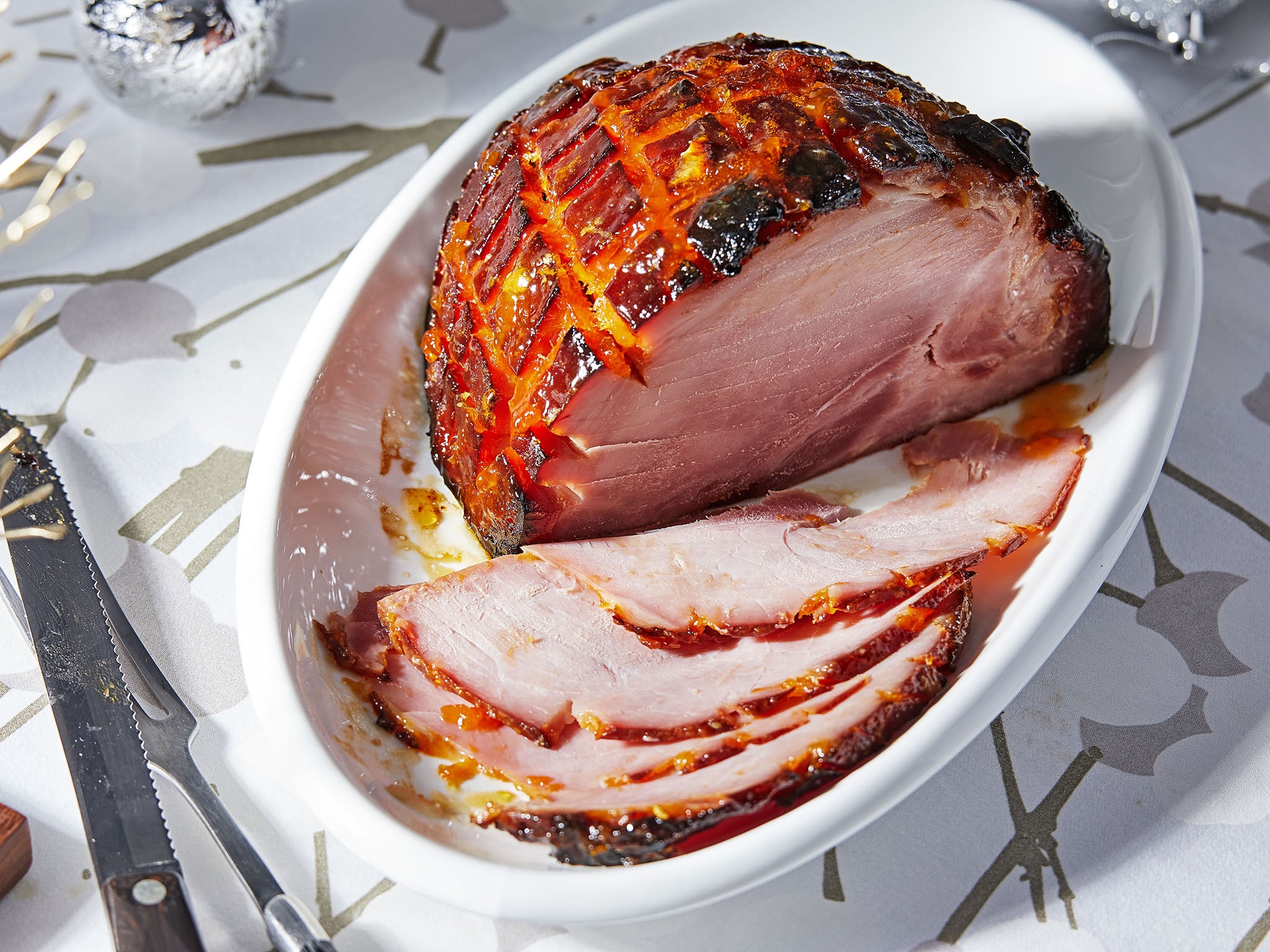
Active time: 15 minutes | Total time: 2 hours 15 minutes
Serves: 4 to 6
A supermarket-bought cooked ham doesn’t need additional cooking to be safe to eat, but baking it a second time allows you to add a lacquer-like glaze that provides sweet tanginess. Basting the ham a few times during the course of the cooking allows the outside to get shiny and caramelised.
If you’d prefer not to use bourbon, you can swap in apple cider or pineapple juice instead. For a few dollars, you can buy one of those little bottles of bourbon like they sell on airplanes; it really gives the glaze a memorable depth of flavour.
Make ahead: The glaze can be made up to 3 days in advance.
Storage notes: Leftover ham can be refrigerated for up to 3 days.
Ingredients:
160g apricot preserves or jam
2 tsp minced or finely grated fresh ginger
2 tbsp bourbon
One (1.4kg) uncured, cooked boneless ham
Method:
Position a rack in the middle of the oven and preheat to 160C. Line a shallow baking tray with foil and spray with nonstick spray.
In a small bowl, combine the apricot preserves, ginger and bourbon and mix until well combined.
Using a sharp paring knife, score the ham by making crosshatch cuts all over the surface about 1.5cm deep and 1.5cm apart, creating a square or diamond pattern. Place the ham cut side down in the baking tray and brush it with about a third of the glaze.
Bake, uncovered, for 45 minutes. Brush the ham with another third of the glaze. Bake for about 45 minutes longer, then brush with the remaining glaze. Bake for an additional 30 minutes, or until the ham is nicely browned and caramelised on the outside.
Remove the ham from the oven and let sit for 10 minutes before slicing.
Braised red cabbage wedges
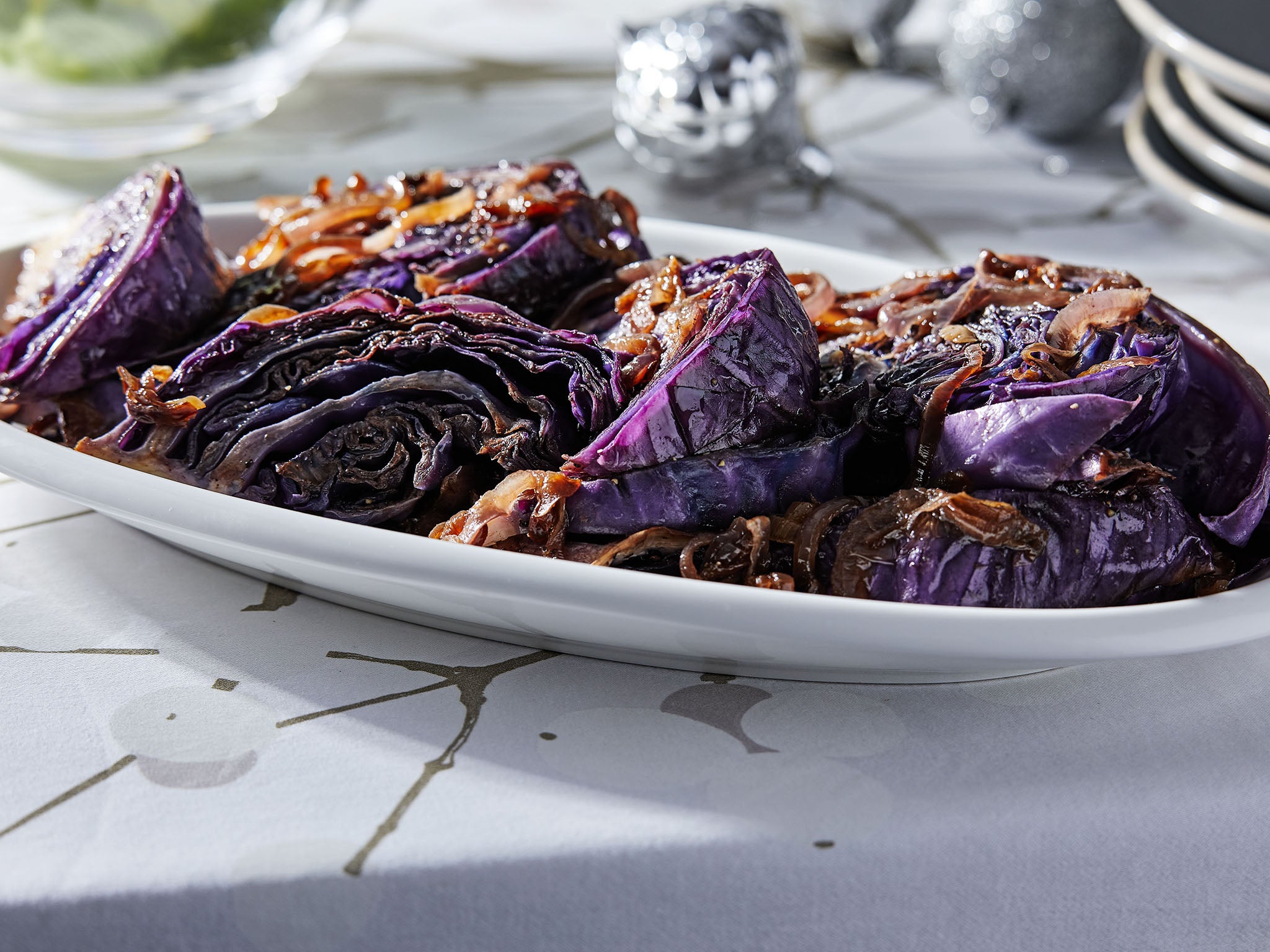
Active time: 45 minutes | Total time: 1 hour 45 minutes
Serves: 4
Cabbage rocks: it’s cheap, plentiful, versatile and it’s there in the winter when the variety of fresh vegetables is at a nadir.
In this recipe, cabbage is cut into wedges, seared and then oven-braised in cider and a bit of vinegar. It becomes soft and buttery and hard to stop eating. Don’t worry if some of the wedges fall apart as you are cutting or cooking them; just scoop up all the pieces and toss them into the pot. When you serve it, try to arrange it so the prettiest wedges are on top.
Storage notes: Leftover cabbage may be tightly covered and refrigerated for up to 4 days.
Ingredients:
3 tbsp unsalted butter, divided
1 large red onion (about 280g), halved and thinly sliced
1 medium head red cabbage (about 900g)
Salt
Freshly ground black pepper
2 tbsp cider vinegar (may substitute red wine vinegar or balsamic vinegar)
120ml apple cider or juice
Method:
In a large, heavy, ovenproof lidded pan over medium heat, melt 1 tablespoon of the butter. Add the onion and cook, stirring occasionally, until tender, about 8 minutes. Transfer the onions to a plate. Remove pan from heat.
Meanwhile, using a chef’s knife, cut the cabbage in half through the stem. Place a cabbage half on the cutting board, flat side down and slice into roughly 2.5cm wedges, leaving enough of the core so that the wedges hold together as much as possible. Trim away the thickest part of the core, as needed. Repeat with the remaining cabbage half.
Position the rack in the middle of the oven and preheat to 160C.
In the same pan, melt another tablespoon of the butter over medium heat. Add half the cabbage wedges, and season with salt and pepper. Cook, without moving them, until lightly browned on the bottom, about 5 minutes, then carefully flip the wedges with a thin metal spatula, season again with salt and pepper, and brown on the other side, about 5 minutes. Toss any loose cabbage leaves in the pan so that they brown on all sides. Transfer the wedges and leaves to another plate. Repeat with the final tablespoon of butter and the remaining cabbage. Transfer the second batch of cabbage to the plate with the first batch.
In the same pan, add the vinegar and apple cider. Return half of the seared cabbage and loose leaves to the pan, sprinkle the cooked onions over, then add the rest of the seared cabbage, placing the prettiest wedges on top.
Cover the pan and place in the oven. Braise for 1 hour, or until the cabbage is tender (a sharp knife should slide in easily).
Serve directly from the pan or arrange on a platter and serve family-style.
Cheddar potato gratin
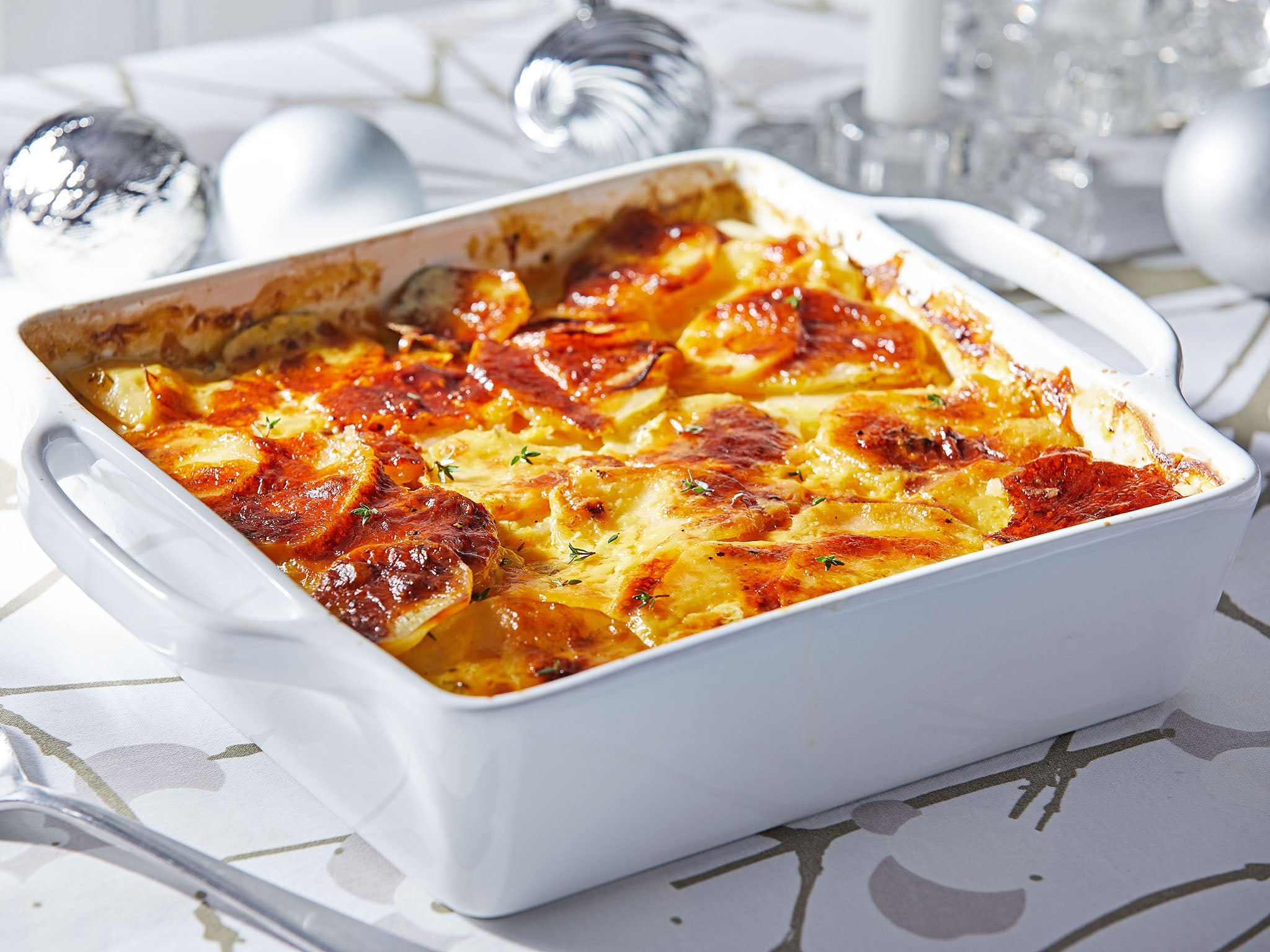
Total time: 2 hours
Serves: 4
This budget-friendly recipe is scaled generously on purpose, because a plate of leftover gratin heated up in the microwave is truly a post-feast breakfast worth getting up early for.
You can use any cheddar that fits your budget, from shredded bagged to a fine aged, hand-grated block. You’ll really taste the cheese, so if you have a few extra bucks to throw into a dish, this would be a good place to do that.
Storage notes: Leftover gratin can be refrigerated for up to 4 days.
Method:
Butter or cooking spray, for greasing the dish
240ml low-sodium chicken broth
240ml heavy cream
2 tbsp dijon mustard
1 tsp salt
½ tsp freshly ground black pepper
1½ tsp fresh thyme leaves (or ½ tsp dried thyme), plus more for optional garnish
1.2kg russet potatoes, peeled and sliced about ⅓cm thin
225g grated sharp cheddar cheese
Method:
Position the rack in the middle of the oven and preheat to 200C. Lightly grease a 22-by-22cm baking dish with butter or cooking spray.
In a medium bowl or a liquid measuring cup, combine the chicken broth, cream, mustard, salt, pepper and thyme.
Layer half the potatoes in the prepared baking dish. Then sprinkle on half the cheese and pour in half of the liquid mixture. Repeat with the remaining potatoes, cheese and liquid.
Cover the pan with foil and bake for 30 minutes. Remove the foil and continue to bake for an additional 45 minutes or so, until the potatoes are tender (a knife slides should in easily) and the top is browned and crispy. Let cool for 15 minutes before serving; and sprinkle with more thyme, if using.
Note: You can make this dish in a 22-by-33cm pan. You’ll get more crispy potatoes on top and a thinner layer of creaminess, but it is just as good. Bake just as directed.
Poached pears with chocolate sauce and crystallised ginger
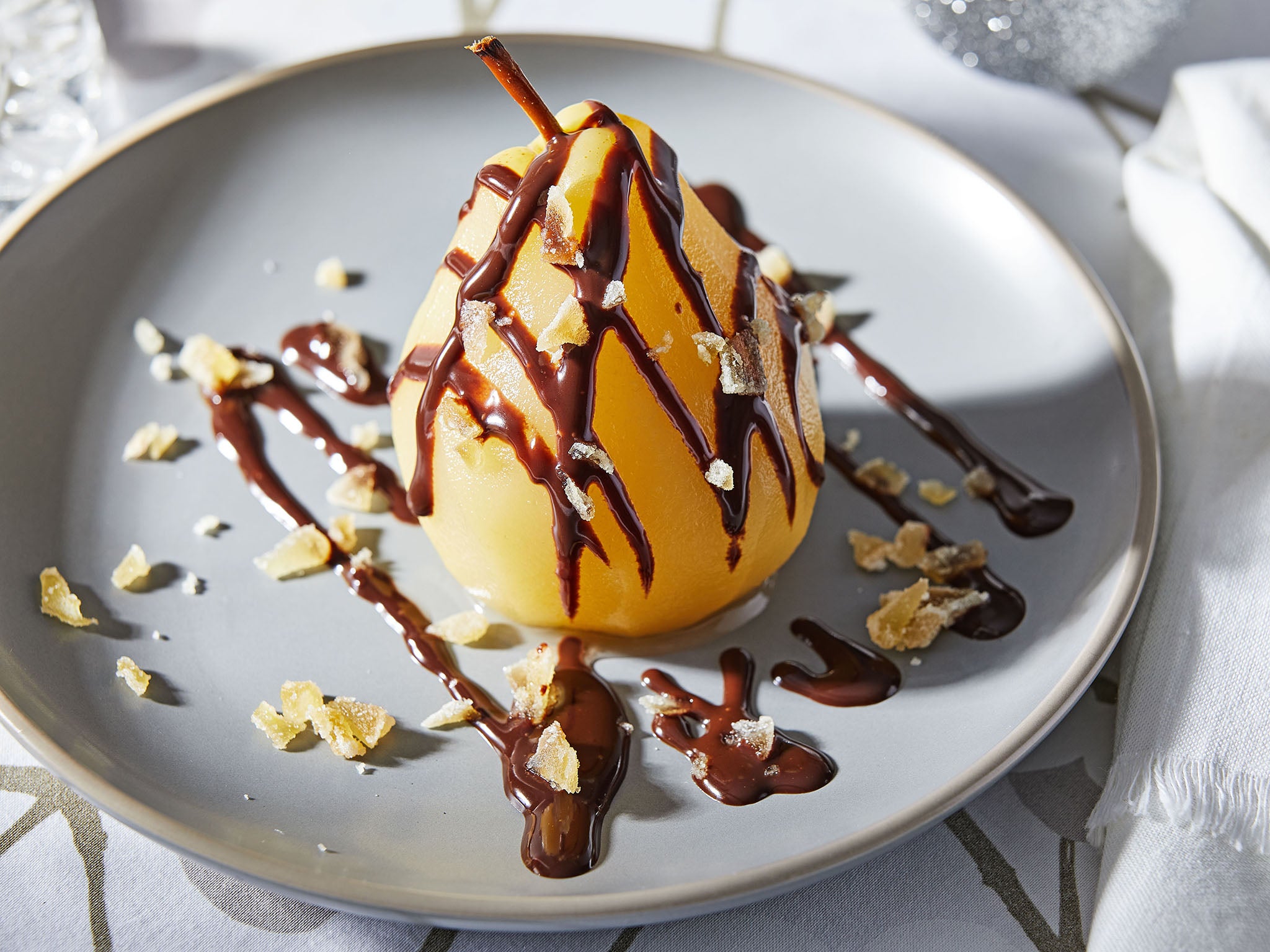
Active time: 30 minutes | Total time: 2 hours 20 minute
Serves: 4
Be sure to use pears that are just turning ripe, not hard but not soft either for this budget-friendly, festive dessert. Bosc, Bartlett and D’Anjou produce delicious results. For a twist, try replacing a cup of apple cider with an equal amount of riesling.
Make ahead: The poached pears may be refrigerated for up to 1 day before serving. Serve chilled or at room temperature.
Ingredients:
For the pears:
475ml apple cider
475ml water
50g light or dark brown sugar
Zest strips from 1 washed lemon, preferably organic
3 sprigs fresh rosemary (optional)
6 black peppercorns
4 just-ripe pears, such as D’Anjou, Barlett or Bosc
For the chocolate sauce:
60ml heavy cream
140g finely chopped semisweet chocolate
¼ tsp sea salt, or more to taste
45g chopped crystallised ginger (optional)
Sweetened whipped cream, for serving (optional)
Method:
Make the pears: in a saucepan just large enough to hold the pears, combine the apple cider, water, brown sugar, lemon zest, rosemary, if using, and peppercorns.
Using a vegetable peeler, peel the pears, leaving them as smooth and neat as possible; try to leave the stem intact. Add the pears to the pot, and cover with a circle of wax or parchment paper to prevent discolouration as the pears cook. Use a lid or a heatproof plate that will fit just inside the diameter of the pot to hold the parchment down.
Turn the heat to medium-high and bring the liquid to a simmer. Reduce the heat to maintain a gentle simmer and cook until the pears are fairly tender but not super-soft, turning every 10 minutes or so, so that all parts of the pear have a chance to be submerged, for 25 to 30 minutes total. The pears are done when the tip of a sharp paring knife or a wooden skewer glides fairly easily into the outside of the pear and meets some resistance as it heads towards the middle. To test this, gently lift a pear out of the pot and insert the tester into the bottom – this will keep them unblemished on the sides.
Remove the pan from the heat and let the pears cool – with the parchment still on but the lid or plate removed – in the poaching liquid until they reach room temperature. The pears will continue to cook in the hot poaching liquid. Either hold at room temperature for a few hours, or transfer the pears to a container and refrigerate for up to 1 day.
Make the chocolate sauce: when ready to serve, place the heavy cream in a small microwave-safe bowl and warm on high until hot but not boiling, about 15 seconds. Place the chocolate chips and salt in another small bowl and pour the hot cream over. Let sit, without stirring, for about 2 minutes, then stir until smooth and the salt is dissolved.
Slice a sliver off the bottom of each pear so they stand up straight. Place each pear on a plate and drizzle each with chocolate sauce. Sprinkle the pears with the chopped crystallised ginger, add a dollop of whipped cream, if using, and serve.
© The Washington Post
Join our commenting forum
Join thought-provoking conversations, follow other Independent readers and see their replies
Comments
Bookmark popover
Removed from bookmarks